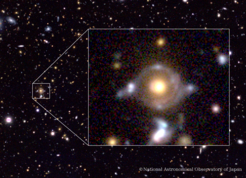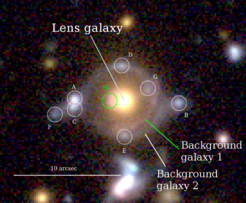The Sky's Ancient Eye
Light from a distant galaxy can be strongly bent by the gravitational influence of a foreground galaxy. This effect is called strong gravitational lensing. Normally a single galaxy is lensed at a time. The same foreground galaxy can – in theory – simultaneously lens multiple background galaxies. Although extremely rare, such a lens system offers a unique opportunity to probe the fundamental physics of galaxies and add to our understanding of cosmology. One such lens system has recently been discovered and the discovery was made not in an astronomer’s office, but in the classroom. It has been dubbed Eye of Horus, and this ancient eye in the sky will help us understand the history of the universe.
Classroom Research Pays Off

Eye of Horus in pseudo colour. There are two arcs/rings with different colours, which are lensed images of two background galaxies.
Subaru Telescope organizes a school for undergraduate students each year. One such session was held in September 2015 at the NAOJ headquarters in Mitaka, Tokyo. Subaru is currently undertaking a massive survey to image a large area of the sky at an unprecedented depth with Hyper Suprime-Cam as part of the Subaru Strategic Programme. A group of astronomers and young students were analysing some of that data at the school when they found a unique lens system. It was a classic case of a serendipitous discovery.
"When I was looking at HSC images with the students, we came across a ring-like galaxy and we immediately recognized it as a strong-lensing signature," said Masayuki Tanaka, the lead author of a science paper on the system’s discovery. "The discovery would not have been possible without the large survey data to find such a rare object, as well as the deep, high quality images to detect light from distant objects."
Arsha Dezuka, a student who was working on the data, was astonished at the find. "It was my first time to look at the astronomical images taken with Hyper Suprime-Cam and I had no idea what the ring-like galaxy is," she said. "It was a great surprise for me to learn that it is such a rare, unique system!"
What They Saw

Identification of the lensed images: The inner arc has a reddish colour, while the outer arc has a blue colour. The circles show the lensed images of the background galaxies and the green and white circles are multiple images of the same background galaxies as the inner and outer arcs, respectively. The yellow object at the center is a massive galaxy at z=0.79, which bends the light from the two galaxies.
A close inspection of the images revealed two distinct arcs/rings of light in different colours. This strongly suggested that two distinct background galaxies are being lensed by the foreground galaxy. The lensing galaxy has a spectroscopic redshift of z = 0.79 (which means it is 6.8 billion light years away) based on data from the Sloan Digital Sky Survey. Follow-up spectroscopic observations of the lensed objects using the infrared-sensitive FIRE spectrometer on the Magellan Telescope confirmed that there are actually two galaxies behind the lens. One lies at z = 1.30 and the other is at z = 1.99 (8.9 and 10.5 billion light years away, respectively).
“Having three galaxies separated by billions of light years but all located on a single sightline from Earth is so rare that it’s like hitting jackpot,” exults Sherry Suyu, co-author from the Max Planck Institute for Astrophysics, who helped to analyze the lensing system and to weigh the lens galaxies using a software that she developed together with Aleksi Halkola. Upon seeing the beautiful lensing system, Suyu pointed out to her collaborators that it resembles an ancient Egyptian symbol known as Eye of Horus, for the sacred eye of an ancient Egyptian deity.
“The system is showing peculiar features with unexpected image splitting, an exciting sign of the possible presence of an invisible clump of dark matter,” Suyu explains. Dark matter does not shine and is extremely difficult to detect - in fact, dark matter has not yet been directly detected. “However, through the gravitational effects of dark matter that imprint on the lensing images, our Eye of Horus is providing a great opportunity for us to “see” it indirectly!”
The survey with Hyper Suprime-Cam is only 30% complete and will collect data for several more years to come. Astronomers expect to find roughly 10 more such systems in the survey, which will provide important insights into the fundamental physics of galaxies as well as how the universe expanded over the last several billion years.







